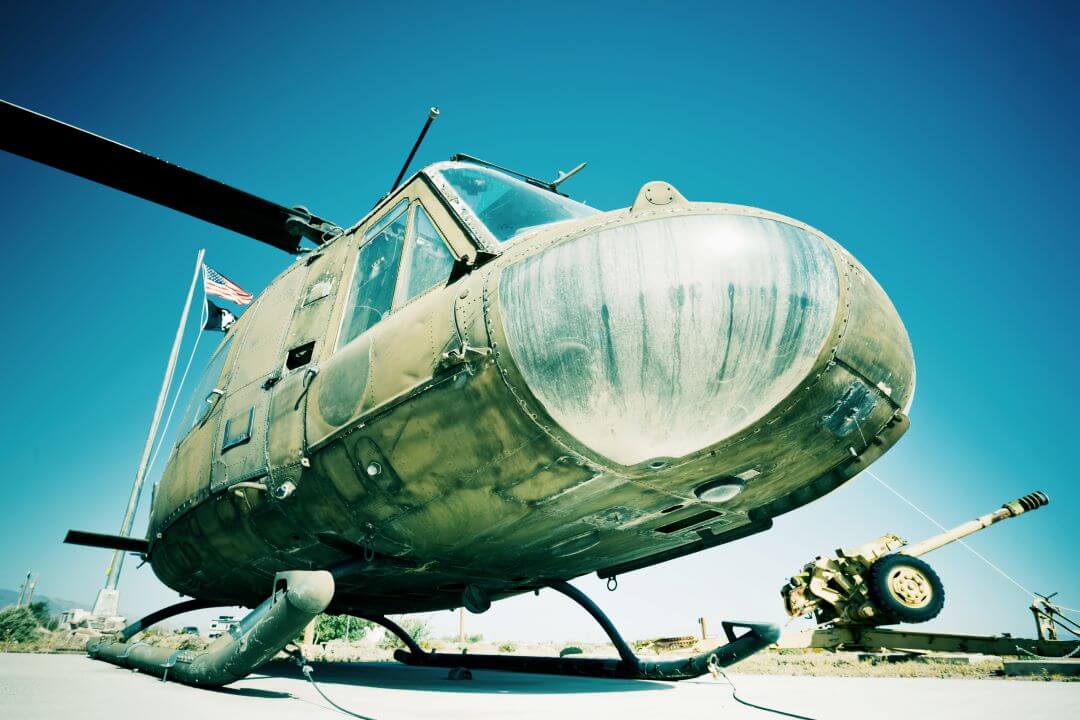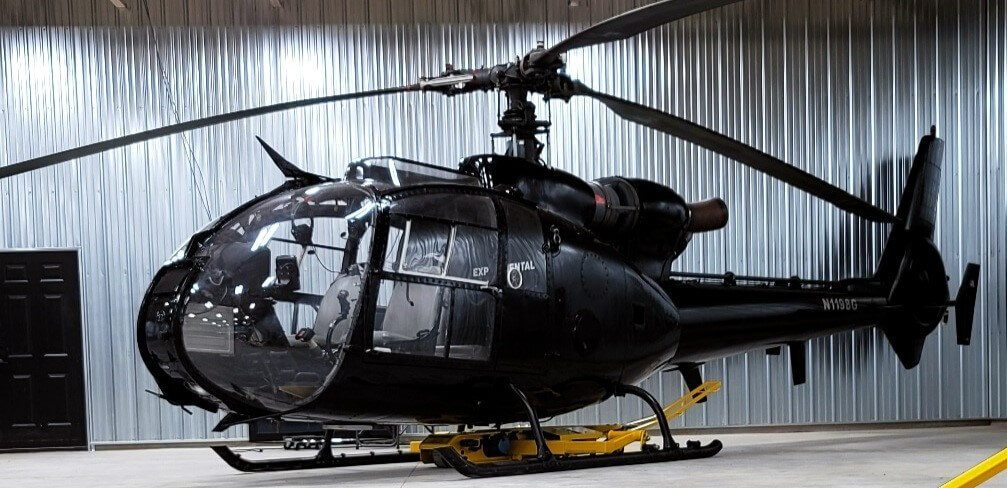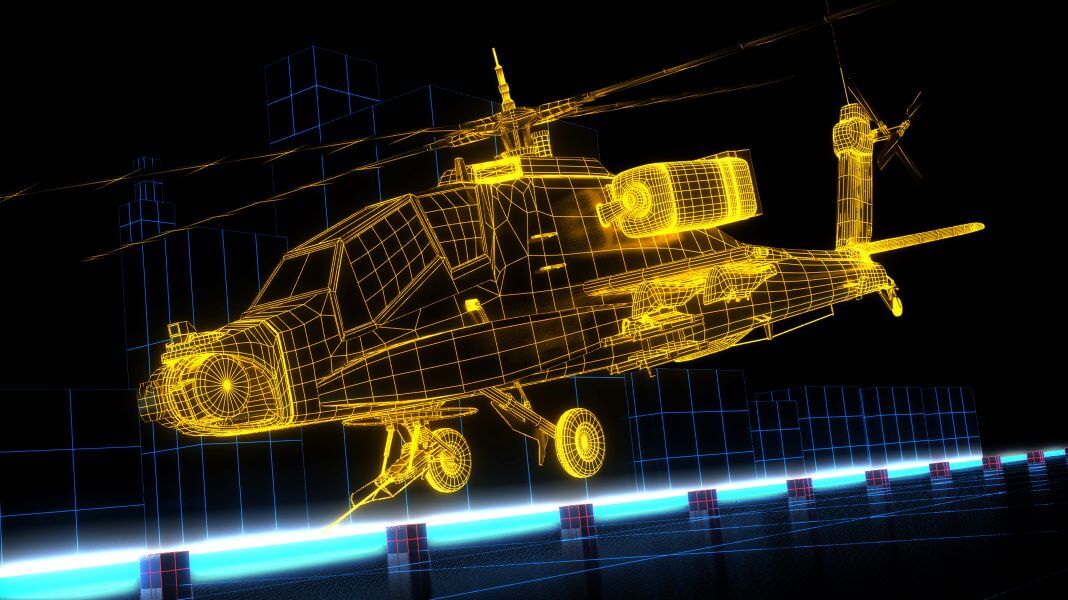Helicopter History Part 2: A History of Helicopters in the Military

In the first part of our helicopter history series, we looked at vertical flight technology from its early beginnings to the early 1900s. In this post, we’ll explore the history of helicopters in the military and how they’ve been used in wartime operations over the decades. From evacuation and troop transport to reconnaissance and attack missions, helicopters have played a vital role in modern warfare around the globe.
WORLD WAR II AND THE PUSH FOR MILITARY HELICOPTERS
During World War II, helicopters saw their first widespread use in military applications. In 1935, the German company Heinkel built and flew the world’s first practical military helicopter. This machine, called the “Heinkel He 49,” was designed as a reconnaissance aircraft and could reach speeds of up to 100 kilometers per hour (62 miles per hour). The Heinkel He 49 was followed by several other German military helicopters, including the “Flettner Fl 282 Kolibri” and the “Focke-Wulf Fw 61.”
In 1939, famed Russian-American aviation designer Igor Sikorsky built and flew the world’s first multi-engine helicopter. This machine, called the “Vought-Sikorsky VS-300,” was powered by two engines and could stay in the air for up to 30 minutes. Sikorsky continued to develop his helicopter design and, in 1942, he built the most advanced helicopter of the time, the “Sikorsky XR-4.” This incredible machine exceeded all previous airspeed and altitude records and was the first mass-produced helicopter to be used by the United States Air Force.
In 1942, the British government commissioned the construction of several hundred “Hoverfly” helicopters for use in rescue missions and other operations. The Hoverfly was based on de la Cierva’s autogiro design and used a single rotor for lift and a small propeller for thrust. It was very slow and could only stay in the air for short periods of time, but it proved to be very useful in rescuing downed pilots and other personnel from behind enemy lines.
In the United States, meanwhile, the American Helicopter Company was founded in 1943 with the goal of designing and building military helicopters. The company’s first machine was the “YH-13 Sioux,” which was designed as a medical evacuation helicopter. The YH-13 first flew in 1945 and saw action in the Korean War just a few years later.
Other notable military helicopters from this era include the British “Westland Wyvern,” the Soviet “Mi-1 Hare,” and the French “SA321 Gazelle.”

An Aérospatiale Gazelle hooked up to a Chopper Spotter
THE POST-WAR RISE OF CIVILIAN HELICOPTERS
After the war, helicopter development continued at a rapid pace, with rotorcraft beginning to be used more and more for civilian applications such as search and rescue, law enforcement, and medical emergencies.
In 1947, Sikorsky Aircraft introduced the first mass-produced helicopter, the “S-51.” The S-51 was a major breakthrough in helicopter design and could stay in the air for up to four hours. It was also the first helicopter to be equipped with a fully enclosed cabin, making it much more comfortable and safer for passengers. Sikorsky would go on to found his own company, Sikorsky Aircraft Corporation, which is still one of the leading manufacturers under the Lockheed Martin brand.
In the same year, Bell Aircraft Corporation designed and built the world’s first turbine-powered helicopter, the “Bell 47.” The Bell 47 was powered by a single turbine engine and could reach speeds of up to 160 kilometers per hour (100 miles per hour). It was the first helicopter to be certified for civilian use, which allowed it to quickly become the most popular helicopter in the world and remained in production until 1974.
Fought between North and South Korea from 1950 to 1953, the Korean War was the first major conflict where helicopters were used in large numbers, turning the air above the battlefield into a swirling mass of steel and rotors. During this period, four rotorcraft in particular—the Bell H-12 Sioux, the Sikorsky H-5, the Hiller OH-23 Raven, and the Sikorsky H-19 Chickasaw—distinguished themselves in the helicopter history books. Check out our other article on the top helicopters of the Korean War to learn more about them.
In 1953, Westland Aircraft introduced the first helicopter specifically designed for anti-submarine warfare (ASW), the “Westland Wasp.” The Wasp was equipped with sonar and other ASW equipment and could be carried on board ships or submarines. It saw action in a number of conflicts, including the Falklands War and the Gulf War.
In 1960, Soviet engineer Nikolai Kamov designed and built a coaxial helicopter known as the “Ka-26 Hoodlum.” Kamov’s design used two rotors that rotated in opposite directions, which cancel out each other’s torque and allowed the helicopter to be more maneuverable than traditional helicopters. The Ka-26 was followed by several other Kamov helicopters, including the “Ka-32” and the “Ka-50 Black Shark.”
MAJOR ADVANCEMENTS IN MILITARY HELICOPTER DESIGN
In the 60s and 70s, a number of advances were made that would go on to shape the helicopters of today. In 1960, the Bell UH-1 “Iroquois,” better known as the “Huey,” became the first turbine-powered helicopter to enter service. The Huey was powered by a single turboshaft engine and quickly became one of the most iconic helicopters in history. It saw action in a number of conflicts, including the Vietnam War, and continues to fly in military and civilian roles all over the world.
To learn more about these legendary rotorcraft, check out our other post that takes a look at the top helicopters of the Vietnam War.
Watch as a Chopper Spotter with prototype arms moves a Huey around a hangar bay
In 1969, Sikorsky Aircraft unveiled the “S-61R Sea King,” the first helicopter specifically designed for maritime operations. The Sea King was equipped with sonar and other ASW equipment and could be operated from ships or submarines. Like the Westland Wasp, it also saw plenty of action in the Falklands War and the Gulf War.
In 1976, Eurocopter (now Airbus Helicopters) introduced the “AS332 Super Puma,” which quickly became one of the most popular helicopters in the world. The Super Puma is powered by two turboshaft engines and can carry up to 24 passengers. It has been used in a variety of roles, including search and rescue, law enforcement, and military operations.
In 1986, Sikorsky Aircraft introduced the “S-70,” which was the first helicopter specifically designed for the United States Army. The S-70 is powered by two turboshaft engines and can reach speeds of up to 315 kilometers per hour (196 miles per hour). It has been used in a number of roles, including transportation, attack, and medical evacuation.
THE MODERN ERA OF HELICOPTERS
By the time the 90s rolled around, advancements in helicopter design and technology were coming in leaps and bounds. In 1992, Eurocopter introduced the “EC120 Colibri,” which was the first helicopter specifically designed for purely civilian use. The Colibri is powered by a single turboshaft engine and can carry up to five passengers. It has been used in a variety of roles, including air taxi, law enforcement, and aerial photography.
The Persian Gulf conflicts of the late 20th and early 21st centuries brought legendary helicopters like the Sikorsky UH-60 Black Hawk and Boeing AH-64 Apache to the forefront. You can learn more about those and other prominent rotorcraft in our look at the top helicopters of the Iraq War.
In 2000, Eurocopter introduced the “EC145,” which was the first helicopter specifically designed for emergency medical services (EMS). The EC145 is powered by two turboshaft engines and can carry up to two patients on stretchers. It has been used in a number of EMS operations all over the world.
In 2005, Bell Helicopter introduced the “V-22 Osprey,” which was the first tiltrotor aircraft to enter service. The Osprey is powered by two turboprop engines and can take off and land like a helicopter but fly like an airplane. It has been used in a number of versatile roles, including military transportation and attack.
Today, helicopters are an essential part of both military and civilian life. They are used by militaries, governments, and businesses in a variety of applications, including transportation, search and rescue, law enforcement, and wartime operations. To learn more, check out our recent post on five ways helicopters play a crucial role in saving lives.
With their ability to take off and land vertically—not to mention the continued advances in helicopter design and technology—helicopters will likely continue to play an important role in our lives for many more decades to come.

WHAT’S IN STORE FOR THE FUTURE OF HELICOPTERS?
While the future sure seems bright, exactly what the helicopter industry will look like five, ten, or even twenty years down the road is anybody’s guess. Then again, perhaps our list of five helicopter trends reshaping the industry will be an indicator of some of the many great things to come. We also recommend you check out our list of the four most exciting new helicopter concepts that are pioneering the future of flight.
One thing’s for certain though—the Chopper Spotter will remain the best way to put your aircraft firmly in its place. Since 1989, Chopper Spotter has served as an industry-best partner for owners and operators in more than 40 countries around the world—and there’s good reason for that.
From hospitals and police departments to military organizations and private operations, we provide safety, maneuverability, and ease of use that is simply unmatched. Request a quote today to start experiencing the ease and maneuverability of the industry’s best ground-handling equipment.